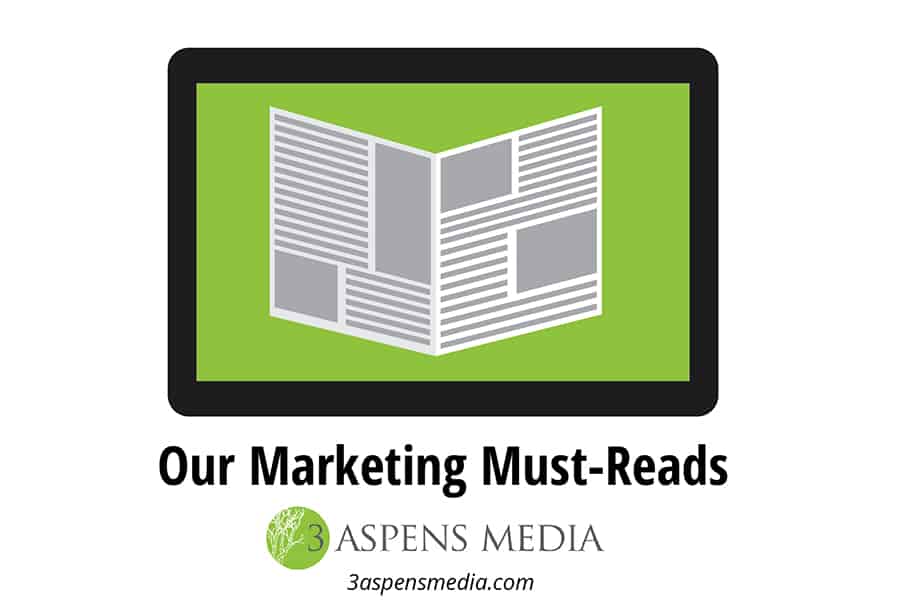We read a lot, and we’re on a lot of email lists. We like it that way, but we know you might not have the time to read every piece on marketing and content that comes your way. In the spirit of sharing, we will occasionally share links to our favorite tips, tricks and insights from around the web on content, marketing and business in general. In this content round-up, we share some our favorites.
Our 7 Favorite Content Marketing Reads (This Month)
1. “The 10 Commandments of Distributor Marketing” from Modern Distribution Management
Ian Heller, president of MDM and former vice president of marketing at a large distributor, produced this great list of 10 must-dos for marketers (and businesses in general) in 2018. Our favorite, in part because we’re often surprised by people who haven’t invested significantly in digital yet: market online. As Heller points out, “the term ‘online marketing’ is becoming redundant: Very little marketing happens without some online component.” We agree.
Read the article here on MDM.com.
2. “Keys to Creating Killer Content and a Social Media Tip Sheet” from The Software & Information Industry Association
In this thought-provoking piece, Bethany Chambers, director of audience engagement for North Coast Media, cautions readers that “‘If you build it, they will come’ is bad advice. You want to identify your audience first, then go where they are,” she says. Don’t focus on going viral. Instead, speak to your audience with a consistent voice. If you’re thinking of their needs, they will respond.
3. “10 Digital Marketing Tips for Small Business Owners” from Chase Small Business Ad Academy
While advice on how small companies can stand out may sound a bit ironic coming from a big company like Chase, this article offer some good tips for standing out in the digital world. Passing along advice from their “panel of digital marketing experts—from Facebook, Twitter, LinkedIn and Yelp,” the article offers ways to help marketers survive the average audience’s short, eight-second attention span. Among them: the recommendation that marketers not settle for being “mobile-friendly,” and instead aim to produce “mobile-centric” content that can be accessed on the go.
4. “Power Words to Use in Copywriting” from Mequoda
This article provides a great list of “power words” to keep you at your desk for copywriting inspiration. “Used judiciously in online copywriting,” the author says, “power words can grab a reader’s attention and help communicate and persuade.” While cautioning against just using them randomly, the author encourages marketers to use them in context, in an orderly format that “moves the reader along to a purchase decision.”
Read the article here on Mequoda.com.
5. “Paper Beats Digital in Many Ways, According to Neuroscience” from Forbes
While digital is easier and more cost effective to create, there is still a place for print marketing in 2018, according to Forbes Contributor Roger Dooley. Science shows print pieces are more memorable and, in some cases, may even convert customers better.
Read the article here on Forbes.com
6. “Study: Audience-Centric Marketing Most Impactful for Each Buying Scenario” from Demand Gen Report
The article, which highlights new research from SiriusDecisions, describes the impact of different types of content – including third-party analyst reports, sales presentations and case studies – on purchase decisions, based on the buyer’s location in the journey. One of the research’s key findings was that “the relationship with the salesperson was considered the least significant driver of the buying decision,” suggesting just how important content is to today’s buyer.
Read the article here on DemandGenReport.com.
7. “How to Make an Emotional Narrative Work for Your Brand” from The Content Strategist
Multiple articles on major marketing leadership websites this month discussed the role of emotion in marketing in both B2C and B2B contexts. In this piece, Shane Snow recounts his experience with Dr. Paul Zak as he is hooked up to an armband device measuring his body’s release of oxytocin, a neurochemical that causes people to “want to help and relate to others.” Snow argues that emotional narratives can help connect prospective customers with brands and outlines the three components that make up a successful emotional narrative.
Read the article here on Contently.com.
Have a great piece you want to share with us? Email it to info@3aspensmedia.com.

